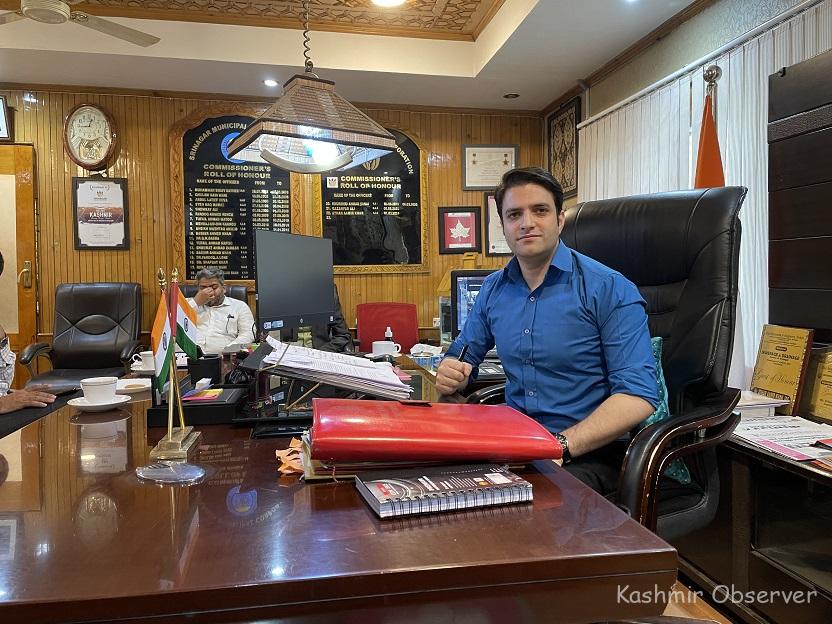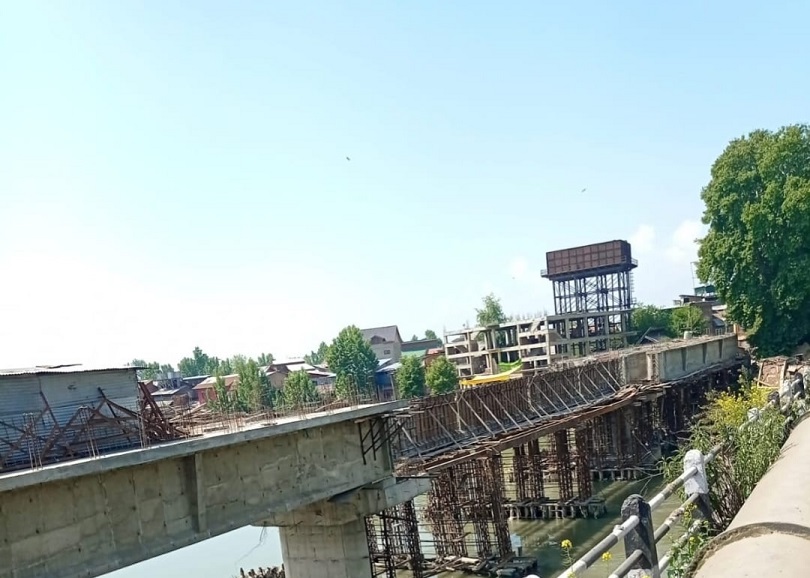
AS Srinagar city is grappling with inadequate roads, traffic snarls, derelict landmarks and stinking wasteland, the inter-departmental coordination has emerged as a crucial factor.
Among the departments, the role of Srinagar Municipal Corporation (SMC) as custodian of urban affairs has come under a sharp scrutiny.
“City management is a joint responsibility,” said Athar Aamir Khan, SMC Commissioner. “We’re coordinating with all different departments including Traffic and Roads and Building (R&B) Departments in implementing projects in Srinagar. The projects include road redesign, junction improvements, footpaths and cycling spaces, road signages along with IT interventions like Intelligent Traffic Management System (ITMS) under Srinagar Smart City Project. The traffic signals have already been commissioned at 66 junctions and handed over to the traffic department. Under ITMS, around 1200 to 1300 RLVD, PTZ and ANPR cameras are being installed.”
But despite these measures, Athar said, Kashmir’s traffic per capita is very high. “Four-wheelers outnumber two-wheelers here, but we’re working on it. Once these projects get completed, traffic management will be better.”
Under Smart City Project, he said, SMC is also working on introducing water transport system in Jhelum and Dal Lake as an additional mode of public transport. This will also help in decongesting the roads.
Along with Lake Conservation and Management Authority (LCMA), Smart City and Irrigation & Flood Control (I&FC) Departments and civil society partners, SMC is reviving the water circulation system, removing encroachments and improving the water quality of Srinagar.
“There used to be a circulation system between Dal Lake, Nigeen, Nallah Amir Khan, Gilsar and Khushal Sar Lakes,” he said. “We’re trying to restore the water movement mechanism.”
In an interview with Kashmir Observer, SMC Commissioner talks about roads and roadmaps of his department. Edited excerpts of the interview follows.
SMC is in news for quite a long time for corruption, embezzlement and nepotism. What’re you doing to stop it?
There’ve been drastic systemic changes done. The services have been digitized. Building permissions, registrations along with other 20 services are all online. You can track applications in your phone at home. All offices of SMC have been put under CCTV surveillance. We now have a 24*7 functional control room for grievances. All works and procurement is done following online process. Weekly review mechanism and progress monitoring has been institutionalized in all wings. Payments, salaries have all been put in the online mode.
We’ve adopted zero tolerance to corruption and dereliction of duty and suspended around forty employees in the past few months and initiated disciplinary action against them.
Departmental actions which were pending for years have been completed. We’re committed to make SMC one of the finest urban governance institutions in the country.
But while putting home in order, is SMC forgetting its core work? For instance, around 1394 kilometers of road in the city falls under SMC. The road was supposed to be macadamized last year, but so far the department has failed to do so? Why?
No not at all. The smaller roads in the city were transferred to SMC last year and we completed most of them under the macadamization plan. Around 70 tenders were floated and the blacktopping continued till the month of October before bad weather halted the process.
We had floated tenders well ahead this year, but there was an issue regarding schedule of rates of certain items between contractors and R&B. So, we did not get response to tenders.
As soon as the issue was resolved, we refloated the tenders and works have been allotted. The macadamisation in city roads which have been planned for this year is starting in a few days.
But many roads in the city are largely pathetic and dotted with potholes—leading to massive traffic snarls. The traffic department says that they need cooperation from other departments including R&B and SMC. Do you’ve any joint plans to ease the traffic mess in the city?
Yes, they need our cooperation and we’re doing that. In fact, SMC has installed traffic lights and handed them over to the traffic department.
Through the Smart City Project, we’re installing an Intelligent Traffic Management System (ITMS) which includes 1200 to 1300 cameras. In the next two to three months, work will be commissioned.
At traffic junctions, we’re marking zebra crossing, pedestrian parking, etc, in a coordinated effort with R&B and Traffic Department. Even our anti-encroachment wing works with the Traffic Department to clear junctions from vendors and shopkeepers.
We take it as a joint responsibility. Once road projects get completed, traffic management will be better.
We’re working together on this.
You may sound upbeat about your urban plans, but SMC has so far failed to tackle the water-logging situation created by a few hours of downpour in the city.
The topography of the city is little peculiar. The storm water doesn’t flow with gravity flow into the river Jhelum. In most of the areas it has to be mechanically pumped out. We’ve upgraded around 85 dewatering stations in city under AMRUT and JTPRF. The capacity has been heavily augmented, the control systems, power backup etc in these have been put above the highest flood level, that’s the 2014 level. Besides new networks have been laid in many areas including Lal Chowk, Mallabagh, Mominabad Bemina, Khomien chowk, Shalteng, etc.
We’ve also commissioned a consulting firm for preparing Srinagar City’s drainage master plan so that henceforth the drainage interventions are done more systematically and in planned manner. The city needs additional 1000 kilometers of drainage network and the drainage master plan will help in planning that.
We’ve also kept around 120 mobile dewatering units for deployment in rains along with 14 sucker machines and 20 desilting machines.
Despite these measures, Srinagar’s second biggest water body Anchar is on the verge of extinction today. Two of its main wetlands—Khushalsar and Gilsar—aren’t in right shape either.
Anchar has been taken up jointly by Forest Department, LCMA, I&FC, Smart City and SMC for rejuvenation.
The revival of Khushalsar and Gilsar lakes is also going in close partnership with local communities and civil society partners including NLCO.
There has been remarkable improvement in these twin lakes. SMC has lifted around 1400 trucks and dumpers of muck and silt from these water bodies.
But wasn’t the restoration initiated by the civil society?
Yes, and that’s something to emulated. For any successful intervention, public ownership is extremely important. If the local community takes the initiative and administration joins in, that’s the best model. Until and unless both work in tandem, things don’t happen.
So, how much time will it take to restore these lakes to their original form?
We’re removing muck from these lakes as well as reviving springs of Srinagar as of now. Silt deposition is a continuous process in water bodies, but we’re cleaning and removing garbage as well and trying to remove encroachments from these lakes.
The aim is to restore the circulation system between Dal Lake, Nigeen, Nallah Amir Khan, Gilsar and Khushal Sar Lakes.
But what’s the progress on Achan dumping site? We were given to understand that a major compost plant will be established there for scientific treatment of the garbage. How long will the City have to bear with the stench?
Well, we’re working on bio-mining that will treat 10 lakh metric tonnes of waste daily dumped at Achan. DPR has been prepared and sent for approval. We are also constructing new scientific landfill cell for safe management of waste.
Right now, the administrative approval has been received and we’ve sent it for getting the technical sanction.
You see, Mughals had built Nishat and Shalimar with a lot of aesthetics, but anyone passing by these two iconic tourist attractions of the city feels as if he or she is passing through an old bus stand now.
We’ve taken the Nishat and Shalimar garden precincts and the Shalimar canal under a Smart City Project. The works have been comprehensively planned, already tendered and allotted. The Good for Construction drawings are being finalized. The work will start in a few days.
In many residential city areas, there’s mushroom growth of commercial spaces causing a lot of inconvenience to residents. How’s SMC allowing them to operate?
No, I disagree. We’re not allowing any illegal construction in the city. Construction happens only when we issue permits. If we receive complaints, we take immediate action.
In Pazwalpora Shalimar, workshops and marble sellers have mushroomed in residential areas. How’s SMC allowing that?
I will send a team there and check it out.
- Syed Mohammad Burhan contributed in this interview
Follow this link to join our WhatsApp group: Join Now
Be Part of Quality Journalism |
Quality journalism takes a lot of time, money and hard work to produce and despite all the hardships we still do it. Our reporters and editors are working overtime in Kashmir and beyond to cover what you care about, break big stories, and expose injustices that can change lives. Today more people are reading Kashmir Observer than ever, but only a handful are paying while advertising revenues are falling fast. |
| ACT NOW |
| MONTHLY | Rs 100 | |
| YEARLY | Rs 1000 | |
| LIFETIME | Rs 10000 | |













